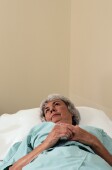
FRIDAY, Nov. 22, 2013 (HealthDay News) — Nursing home residents whose beds have newer high-density foam mattresses may not have to be turned every two hours to prevent bedsores, according to a new study.
The two-hour standard, which has been used for more than 50 years, was necessary because older mattresses that had spring coils and were covered in thick plastic put more pressure on residents’ bodies than the newer high-density foam mattresses, the researchers explained.
Their study included 960 nursing home residents in 29 facilities in the United States and Canada who had a moderate to high risk of developing bedsores (also called pressure sores) and had high-density foam mattresses on their beds. The participants were randomly assigned to be turned at intervals of two, three or four hours.
After three weeks, none of the residents had developed serious bedsores, according to the U.S. National Institutes of Health-funded study recently published in the Journal of the American Geriatrics Society.
“We are very interested in preventing pressure ulcers. It’s a serious health problem. Also, we’re interested in improving care for nursing home residents. Turning residents every two hours throughout the night awakens them, and many people can’t go back to sleep, therefore decreasing their quality of life,” study leader Nancy Bergstrom, associate dean at the University of Texas Health Science Center at Houston School of Nursing, said in a center news release.
The study findings show “that turning residents every two hours may no longer be necessary when high-density mattresses are in place and nursing time can be used to attend to other resident needs, such as feeding, assisted mobility and ultimately develop a stronger relationship with their residents,” study co-leader Susan Horn, of the Institute for Clinical Outcomes Research, said in the news release.
More information
The American Academy of Family Physicians has more about bedsores.
Copyright © 2025 HealthDay. All rights reserved.

